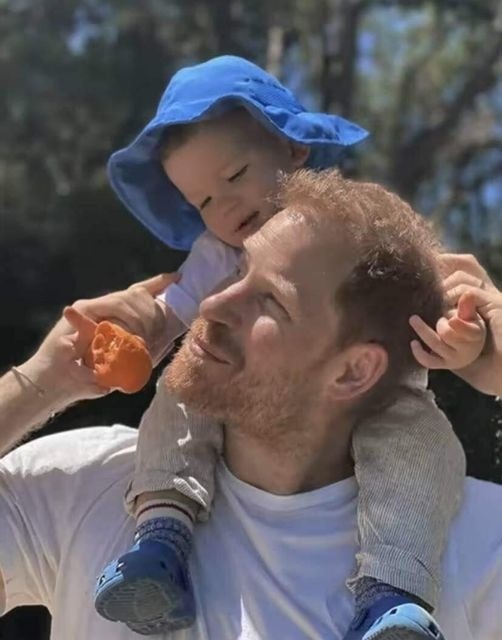Prince Harry revealed many details about his life in his tell-all memoir Spare. He discussed life growing up as a royal and the conflicts behind the scenes. There were anecdotes about his time in the army and the loss of his mother, Princess Diana. He also shared information about Meghan Markle and his children. Although Harry and Meghan remain public figures, they’ve tried to shield their kids from the spotlight. Therefore, not much has been known about Archie and Lilibet until the Harry & Meghan documentary series in December, and now, with Spare.
Behind the Scenes at Archie’s Birth
On May 6, 2019, Archie Harrison Mountbatten-Windsor was born at the Portland Hospital in London. Unlike other royal births, the family did not take photos on the hospital steps afterward. (Remember, this was before Harry and Meghan’s emancipation in early 2020.) Harry was determined to keep any details about his newborn away from the press. This decision was in line with Harry’s well-documented disdain for paparazzi.
Prince Harry and Prince William and his children were all born at St. Mary’s Hospital, where the traditional photo shoot on the steps took place. Meanwhile, Meghan’s doctor worked at Portland Hospital so they chose to have the birth there. Plus, the press would not be able to crowd the entrance of this building due to safety considerations.
In their documentary series, Meghan opened up about her anxiety surrounding Archie’s birth. “There was already the pressure of the picture on the steps. …But I had been really worried going into that labor because I’m older, I didn’t know if I’d have to have a C-section, and I had a very longstanding relationship with my doctor, and that’s who I trusted with my pregnancy,” she said.
The post-birth photoshoot and interviews ended up taking place two days later. But in his memoir, Prince Harry revealed new details about the birth. For one thing, he got high on laughing gas while Meghan was in labor in an effort to calm himself down. “But I saw two ways of enhancing my calm. One: Nando’s chicken (brought by our bodyguards). Two: A canister of laughing gas beside Meg’s bed. I took several slow, penetrating hits,” Harry wrote. “Meg was so calm. I was calm too. Meg, bouncing on a giant purple ball, a proven way of giving nature a push, laughed and rolled her eyes. I took several more hits, and now I was bouncing too.”
He added that the nurse had tried to give Meghan the laughing gas when her contractions came faster, but Harry had already taken all of it. “I could see the thought slowly dawning. Gracious, the husband’s had it all. ‘Sorry,’ I said meekly. Meg laughed, the nurse had to laugh, and quickly changed the canister.” In the end, the doctors gave Meghan an epidural to help with the pain.
Later, at the birth of Lilibet, Harry stayed sober. “This time I didn’t touch the laughing gas (because there was none.) I was fully present,” he wrote. [1]
Other Revelations from Prince Harry’s Memoir
Prince Harry’s memoir delves into many aspects of his life, from his relationships with others in the royal family to his years in the army, meeting Meghan Markle, and processing Princess Diana’s death. He spoke about his fraught relationship with his brother, Princes William. He explained that William was viewed as ‘the heir’ while Harry was ‘the spare,’ hence the title.
Harry spoke about his drug usage, including trying cocaine for the first time at 17. “It wasn’t much fun and it did not make me feel especially happy as it seemed to do to everyone else, but it did make me feel different, and that was my main objective. I was a 17-year-old boy ready to try anything that altered the pre-established order,” he wrote. Although he had sampled with drugs on different occasions, he denies the media’s claims that he was an addict.
One of his more controversial chapters mentions that he had killed 25 people while serving in Afghanistan as a helicopter pilot. He justified the deaths saying they were Taliban insurgents trying to kill his fellow soldiers. “It wasn’t a statistic that filled me with pride but nor did it leave me ashamed. When I found myself plunged in the heat and confusion of combat I didn’t think of those 25 as people. They were chess pieces removed from the board, Bad people eliminated before they could kill Good people.” [2]
When he was 23 years old, he was in Paris for the 2007 Rugby World Cup semifinal. He decided to drive through the tunnel where the fatal crash killed his mother in 1997, at the same speed her car had been going. But the experience was more triggering than cathartic. “I’d told myself that I wanted closure, but I didn’t really. Deep down, I’d hoped to feel in that tunnel what I’d felt when JLP gave me the police files—disbelief. Doubt. Instead, that was the night all doubt fell away. She’s dead, I thought. My God, she’s really gone for good.” [3]
